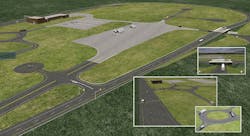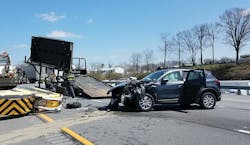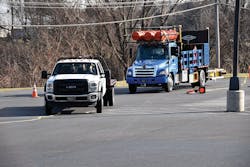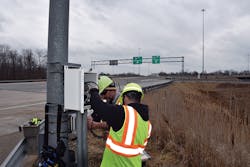Steering the future in the right direction
As part of a commitment to be leaders in the future of transportation technology, five state agencies and seven academic institutions in Michigan, Ohio and Pennsylvania formed a multi-state partnership more than a year ago to work together on self-driving and connected vehicle initiatives.
The Smart Belt Coalition’s (SBC) ultimate goal is to deploy innovative and strategic technology that boosts safety, mobility, economic competitiveness and overall quality of life. The SBC serves a three-state area under the jurisdiction of the respective coalition state departments of transportation and toll agencies. Together, these systems span 173,858 lane miles and support 362.5 billion annual vehicle trips.
Member entities are collaborating to support testing of various automated and connected vehicles at the region’s testing facilities and on varying terrain during a full range of weather conditions and across diverse urban and rural roadways.
One such innovation, truck platooning, is a technique where two or more trucks travel in close proximity to reduce the aerodynamic drag of vehicles in the platoon, which results in fuel savings and reduced vehicle emissions. A project being planned by the SBC to host a demonstration of truck platooning will provide an early opportunity to prove the concept of operating truck platoons across jurisdictional and state lines.
Wireless roadside units such as this one have been deployed along the Ohio Turnpike.
Dollars and sense
From an economic perspective, Michigan, Ohio and Pennsylvania together represent a slice of the U.S. economy that rivals California and Texas, generating $1.8 trillion in gross domestic product in 2016. The three states are home to 34.3 million residents as well as the metropolitan hubs of Philadelphia, Pittsburgh, Cincinnati, Columbus, Cleveland and Detroit. Collectively, the tri-state region moves more than 14% of all national goods valued at more than $2.8 trillion domestically and internationally.
“Collaborating with Michigan and Pennsylvania will be an advantage for Ohio and the region as we share information and work toward adopting standard technologies that will make our roadway even safer and more efficient,” said Ohio Turnpike Executive Director Randy Cole. “We want to make sure any mobility and safety advancements we make here are aligned across a much larger region and not isolated to Ohio.”
The regulatory and research organizations in the tri-state area will share data for research and future deployment of technologies. The members currently include: the Ohio Department of Transportation; the Ohio Turnpike and Infrastructure Commission; The Ohio State University; the Transportation Research Center; Kettering University; the Michigan Department of Transportation; the American Center for Mobility; the University of Michigan; the Pennsylvania Department of Transportation; the Pennsylvania Turnpike Commission; Penn State University; and Carnegie Mellon University.
Facilities such as the Pennsylvania Safety Transportation and Research Track (shown above) are thrusting HAV testing to the forefront of research.
Within the tri-state area, there are several testing facilities as well as Smart City Columbus, Ohio. Key testing facilities include:
- Mcity (Ann Arbor, Mich.);
- Kettering University GM Mobility Research Center (Flint, Mich.);
- American Center for Mobility (Ypsilanti, Mich.);
- Transportation Research Center (East Liberty, Ohio);
- Center for Automotive Research (Columbus, Ohio);
- National Robotics Engineering Center (Pittsburgh, Pa.);
- Uber Advanced Technologies Group Center (Pittsburgh, Pa.); and
- Thomas D. Larson Transportation Institute (University Park, Pa.).
The SBC has met several times since 2016 and has collaborated on speaking opportunities including sending a panel of speakers to the ITS World Congress in Montreal in 2017. It officially formalized its partnership through a letter of understanding.
Recently, the coalition prepared and approved a strategic plan that focuses on connected and automated applications in work zones, traffic incident management and commercial freight.
Experts across the country and around the globe agree, existing approaches to improving safety have diminished returns, mostly because driver distractions and impairments cannot be stopped. According to NHTSA, 94% of crashes involve human error, and 41% of those can be attributed to some type of distraction.
According to NHTSA, 94% of vehicle crashes are the result of human error.
Meeting the need
The Pennsylvania Turnpike Commission (PTC) and the Pennsylvania Department of Transportation (PennDOT) also are founding members of the Smart Belt Coalition.
“We recognize that our customers do not see agency boundaries and that we must work with other agencies to prepare for connected and automated vehicles while delivering safety, mobility and customer value,” said Leslie Richards, PTC Chair and PennDOT Secretary of Transportation.
Pennsylvania has taken a leading role to lay the groundwork for highly automated vehicles (HAV). Carnegie Mellon University in Pittsburgh has been researching this technology for decades and has played a key role in attracting important HAV players to Pittsburgh. PennDOT began working with the university on this topic in 2013, and in 2016 formed an Autonomous Vehicle Task Force to develop guidance and proposed legislation to oversee HAV development in a safe and effective manner. The U.S. Department of Transportation has named Pittsburgh and the test track at Penn State’s Thomas Larson Transportation Institute as formal HAV testing beds.
Simultaneously, the Pennsylvania Turnpike is preparing its foundation for the future. They are advancing a P3 project to install fiber across the entire system to support connected and automated vehicles, as well as cashless tolling. They are also planning to make their roadways smarter by deploying edge computing solutions that will allow the cars of the future to exchange safety and mobility alerts with the Turnpike.
“The average age of a vehicle on our system is about eight years versus more than 11 years elsewhere,” said Mark Compton, PTC CEO. “Cars, in fact, are already becoming smarter, more connected, and autonomous, so participating in the Smart Belt Coalition advances our abilities to meet the needs of those drivers who will be on our roadway.”
PennDOT Transportation Secretary Leslie Richards gets an upfront look at a HAV testing vehicle.
Dug in for testing
Michigan has over 115 Dedicated Short-Range Communications (DSRC) Roadside Units (RSU) for connected vehicle communications throughout the state, and currently underway is the construction of 120 miles of technology-enabled “smart corridors” that will span I-96, I-696, I-94, and U.S. 23. Smart corridors use DSRC RSUs and applications to improve driver safety and mobility.
Michigan also is home to two permanent, purpose-built autonomous vehicle testing sites.
Mcity, a 32-acre connected and autonomous vehicle testing site, opened in 2015 at the University of Michigan. Mcity simulates the broad range of complexities vehicles encounter in urban and suburban environments. It includes approximately five lane-miles of roads with intersections, traffic signs and signals, sidewalks, benches, simulated buildings, street lights, and obstacles such as construction barriers.
The American Center for Mobility (ACM), which opened in December 2017, serves as a national center for connected and automated vehicle (CAV) research, testing, product development, validation and certification. At more than 500 acres, the ACM will be used by government, industry and academia to create and set industry standards, and offers diverse driving areas such as a high-speed loop, off-road, urban, rural, residential and commercial environments.
“The unprecedented collaboration between government, private industry and academia has enabled our success in Michigan,” said Kirk Steudle, director of the Michigan Department of Transportation. “The Smart Belt Coalition continues that spirit of collaboration as we join our partners in other states in using technology to make travel safer and work toward our goal of zero deaths.”
Truck platoon testing at Mcity.
Coordinating at all levels
In Ohio, partners within the state are collaborating under the umbrella of “DriveOhio,” an effort to cooperate at the state and local level coordinated by Governor John Kasich, the Ohio Department of Transportation, the Ohio Turnpike, the Ohio Department of Public Safety and Jobs Ohio.
As a partner of DriveOhio, the Ohio Turnpike offers six lanes and 241 miles of well-maintained roadway, including 160 miles with three lanes, 31 interchanges and 14 service plazas, making it an ideal laboratory to study self-driving vehicles over a continuous, uninterrupted course.
In addition, the Turnpike’s roadway is already equipped with a fiber-optic network that can be adapted for short-range, vehicle-to-infrastructure and vehicle-to-vehicle communications. Its location makes it the centerpiece of a contiguous interstate highway test corridor that would stretch first from Pittsburgh to Detroit and eventually from New York to Chicago.
The Ohio Turnpike also is getting ready to go live with a DSRC proof-of-concept project to operationalize the Turnpike’s snow and ice operations and traffic-incident management. Installations of onboard and roadside equipment have taken place this past winter, and the system went live during the summer.
Meanwhile, the Ohio Department of Transportation is working to establish the U.S. 33 Smart Mobility Corridor by installing high-capacity fiber-optic cable on a 35-mile stretch of four-lane, limited-access highway between Dublin and East Liberty, northwest of Columbus. Both roadways will utilize sensors that can communicate with autonomous and connected vehicles in real-time about current and upcoming driving conditions. The sensors also provide more frequent and accurate traffic counts, weather and surface condition monitoring, and incident-management improvements.
DSRC installation on the Ohio Turnpike.
Measurable results of connected vehicle technology using DSRC will include savings on snow and ice materials like salt and liquid deicer, as well as labor hours. Data gathered from snowplow fleets will be analyzed to look for efficiencies. More efficient traffic-incident management and warnings to drivers with connected vehicle technologies built into their personal vehicles are expected to reduce traffic crashes, especially in work zones. Fewer crashes will mean fewer injuries and fewer fatalities.
These emerging technologies will prepare the way for a safer future and will help change the states’ economies and provide better mobility options to underserved populations in our society. Connected vehicle and highly automated vehicle technology, including self-driving, will help blind and disabled citizens achieve greater independence and productivity in the workplace, as well as complement public transit in providing economically disadvantaged populations with access to jobs.
New mobility options will further help society address a multitude of challenges arising from a growing senior population often referred to as the “Silver Tsunami.”
“The opportunity to provide additional services, safety and reliability positions participant states for a very bright future,” added Cole.
Two independent studies recently both projected up to a 90% reduction in highway fatalities through the adoption of these emerging technologies. That projection translates to longer, better, more productive lives, and more efficient and less costly transportation for state and local economies. Over the longer term, the resulting economic efficiencies will benefit SBC state manufacturers and farmers, because it will cost less to get their goods to market.
“As we proceed, we appreciate the continued support of our respective legislative bodies, transportation partners and communities,” said Cole. “We look forward to input as we prepare for changes in the transportation industry unlike anything we have seen in our lifetimes.”
------------
About the author:
Newbacher is the public information officer for the Ohio Turnpike and Infrastructure Commission. Placey is manager of media and public relations for the Pennsylvania Turnpike Commission. Cranson is in the director of communications for the Michigan Department of Transportation.






